oil level FORD MUSTANG 2022 Owners Manual
[x] Cancel search | Manufacturer: FORD, Model Year: 2022, Model line: MUSTANG, Model: FORD MUSTANG 2022Pages: 528, PDF Size: 10.04 MB
Page 14 of 528
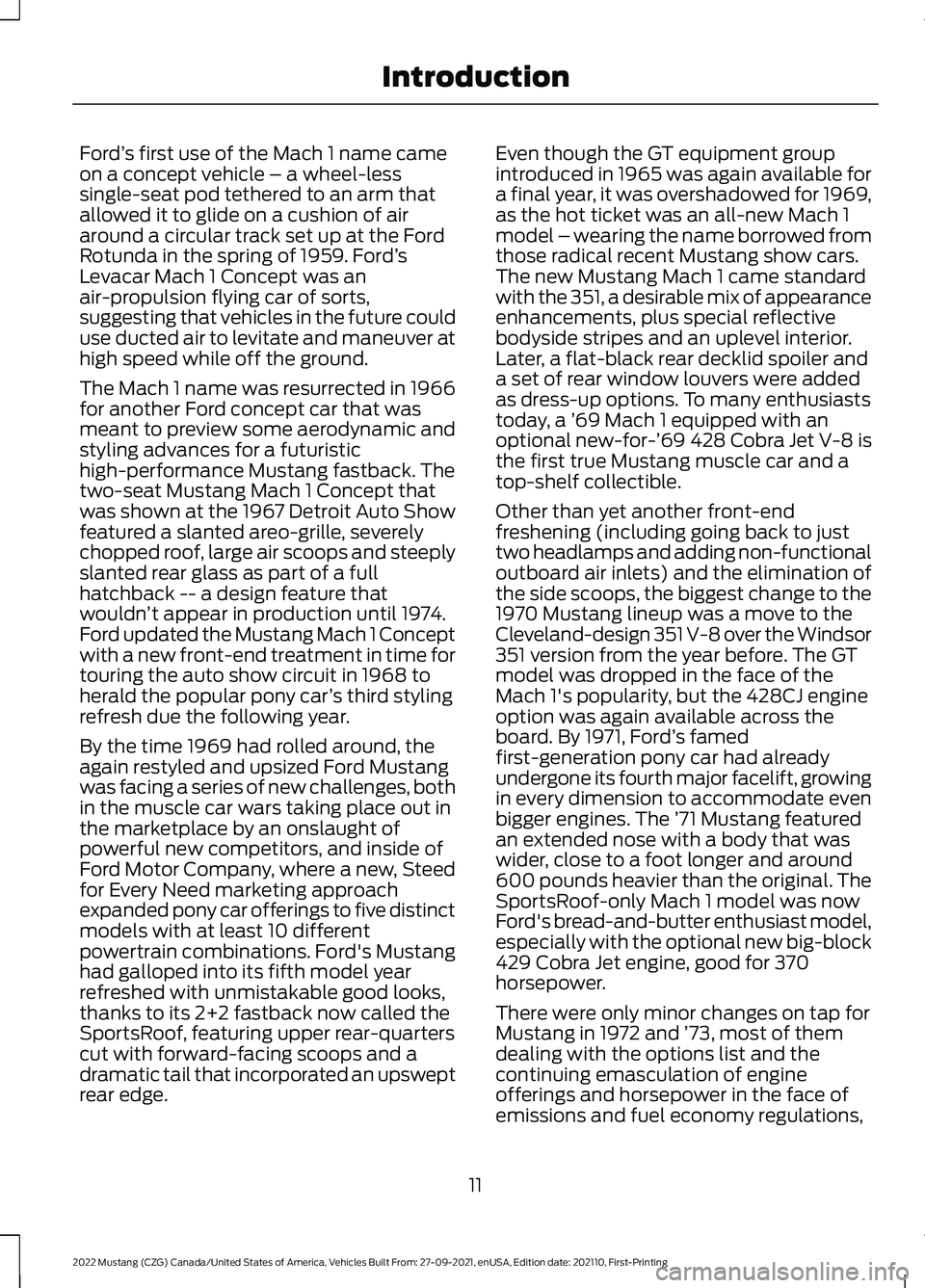
Ford
’s first use of the Mach 1 name came
on a concept vehicle – a wheel-less
single-seat pod tethered to an arm that
allowed it to glide on a cushion of air
around a circular track set up at the Ford
Rotunda in the spring of 1959. Ford ’s
Levacar Mach 1 Concept was an
air-propulsion flying car of sorts,
suggesting that vehicles in the future could
use ducted air to levitate and maneuver at
high speed while off the ground.
The Mach 1 name was resurrected in 1966
for another Ford concept car that was
meant to preview some aerodynamic and
styling advances for a futuristic
high-performance Mustang fastback. The
two-seat Mustang Mach 1 Concept that
was shown at the 1967 Detroit Auto Show
featured a slanted areo-grille, severely
chopped roof, large air scoops and steeply
slanted rear glass as part of a full
hatchback -- a design feature that
wouldn ’t appear in production until 1974.
Ford updated the Mustang Mach 1 Concept
with a new front-end treatment in time for
touring the auto show circuit in 1968 to
herald the popular pony car ’s third styling
refresh due the following year.
By the time 1969 had rolled around, the
again restyled and upsized Ford Mustang
was facing a series of new challenges, both
in the muscle car wars taking place out in
the marketplace by an onslaught of
powerful new competitors, and inside of
Ford Motor Company, where a new, Steed
for Every Need marketing approach
expanded pony car offerings to five distinct
models with at least 10 different
powertrain combinations. Ford's Mustang
had galloped into its fifth model year
refreshed with unmistakable good looks,
thanks to its 2+2 fastback now called the
SportsRoof, featuring upper rear-quarters
cut with forward-facing scoops and a
dramatic tail that incorporated an upswept
rear edge. Even though the GT equipment group
introduced in 1965 was again available for
a final year, it was overshadowed for 1969,
as the hot ticket was an all-new Mach 1
model – wearing the name borrowed from
those radical recent Mustang show cars.
The new Mustang Mach 1 came standard
with the 351, a desirable mix of appearance
enhancements, plus special reflective
bodyside stripes and an uplevel interior.
Later, a flat-black rear decklid spoiler and
a set of rear window louvers were added
as dress-up options. To many enthusiasts
today, a ’
69 Mach 1 equipped with an
optional new-for-’ 69 428 Cobra Jet V-8 is
the first true Mustang muscle car and a
top-shelf collectible.
Other than yet another front-end
freshening (including going back to just
two headlamps and adding non-functional
outboard air inlets) and the elimination of
the side scoops, the biggest change to the
1970 Mustang lineup was a move to the
Cleveland-design 351 V-8 over the Windsor
351 version from the year before. The GT
model was dropped in the face of the
Mach 1's popularity, but the 428CJ engine
option was again available across the
board. By 1971, Ford ’s famed
first-generation pony car had already
undergone its fourth major facelift, growing
in every dimension to accommodate even
bigger engines. The ’ 71 Mustang featured
an extended nose with a body that was
wider, close to a foot longer and around
600 pounds heavier than the original. The
SportsRoof-only Mach 1 model was now
Ford's bread-and-butter enthusiast model,
especially with the optional new big-block
429 Cobra Jet engine, good for 370
horsepower.
There were only minor changes on tap for
Mustang in 1972 and ’ 73, most of them
dealing with the options list and the
continuing emasculation of engine
offerings and horsepower in the face of
emissions and fuel economy regulations,
11
2022 Mustang (CZG) Canada/United States of America, Vehicles Built From: 27-09-2021, enUSA, Edition date: 202110, First-Printing Introduction
Page 15 of 528
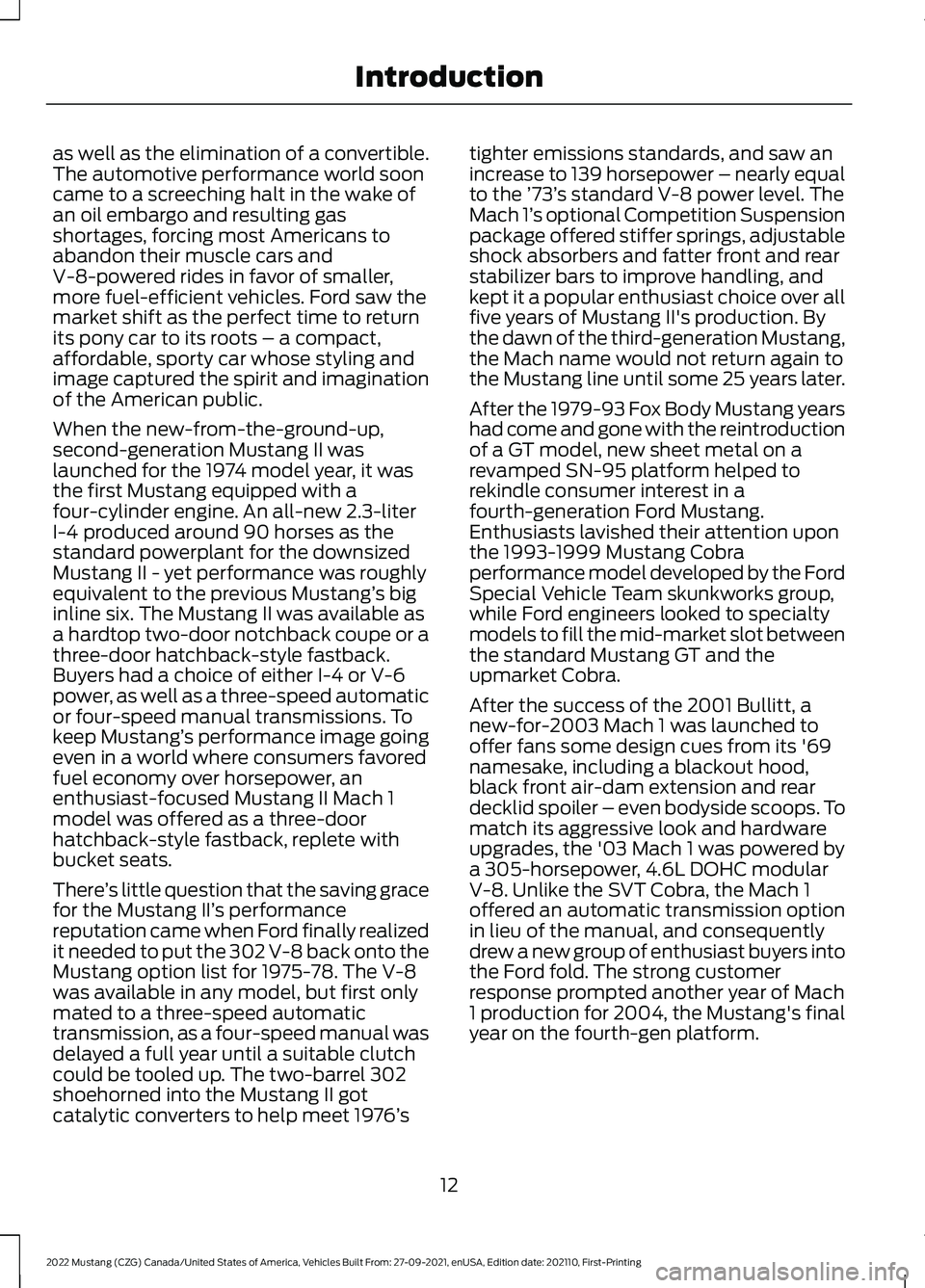
as well as the elimination of a convertible.
The automotive performance world soon
came to a screeching halt in the wake of
an oil embargo and resulting gas
shortages, forcing most Americans to
abandon their muscle cars and
V-8-powered rides in favor of smaller,
more fuel-efficient vehicles. Ford saw the
market shift as the perfect time to return
its pony car to its roots – a compact,
affordable, sporty car whose styling and
image captured the spirit and imagination
of the American public.
When the new-from-the-ground-up,
second-generation Mustang II was
launched for the 1974 model year, it was
the first Mustang equipped with a
four-cylinder engine. An all-new 2.3-liter
I-4 produced around 90 horses as the
standard powerplant for the downsized
Mustang II - yet performance was roughly
equivalent to the previous Mustang’
s big
inline six. The Mustang II was available as
a hardtop two-door notchback coupe or a
three-door hatchback-style fastback.
Buyers had a choice of either I-4 or V-6
power, as well as a three-speed automatic
or four-speed manual transmissions. To
keep Mustang’ s performance image going
even in a world where consumers favored
fuel economy over horsepower, an
enthusiast-focused Mustang II Mach 1
model was offered as a three-door
hatchback-style fastback, replete with
bucket seats.
There ’s little question that the saving grace
for the Mustang II’ s performance
reputation came when Ford finally realized
it needed to put the 302 V-8 back onto the
Mustang option list for 1975-78. The V-8
was available in any model, but first only
mated to a three-speed automatic
transmission, as a four-speed manual was
delayed a full year until a suitable clutch
could be tooled up. The two-barrel 302
shoehorned into the Mustang II got
catalytic converters to help meet 1976 ’s tighter emissions standards, and saw an
increase to 139 horsepower – nearly equal
to the ’
73’s standard V-8 power level. The
Mach 1’ s optional Competition Suspension
package offered stiffer springs, adjustable
shock absorbers and fatter front and rear
stabilizer bars to improve handling, and
kept it a popular enthusiast choice over all
five years of Mustang II's production. By
the dawn of the third-generation Mustang,
the Mach name would not return again to
the Mustang line until some 25 years later.
After the 1979-93 Fox Body Mustang years
had come and gone with the reintroduction
of a GT model, new sheet metal on a
revamped SN-95 platform helped to
rekindle consumer interest in a
fourth-generation Ford Mustang.
Enthusiasts lavished their attention upon
the 1993-1999 Mustang Cobra
performance model developed by the Ford
Special Vehicle Team skunkworks group,
while Ford engineers looked to specialty
models to fill the mid-market slot between
the standard Mustang GT and the
upmarket Cobra.
After the success of the 2001 Bullitt, a
new-for-2003 Mach 1 was launched to
offer fans some design cues from its '69
namesake, including a blackout hood,
black front air-dam extension and rear
decklid spoiler – even bodyside scoops. To
match its aggressive look and hardware
upgrades, the '03 Mach 1 was powered by
a 305-horsepower, 4.6L DOHC modular
V-8. Unlike the SVT Cobra, the Mach 1
offered an automatic transmission option
in lieu of the manual, and consequently
drew a new group of enthusiast buyers into
the Ford fold. The strong customer
response prompted another year of Mach
1 production for 2004, the Mustang's final
year on the fourth-gen platform.
12
2022 Mustang (CZG) Canada/United States of America, Vehicles Built From: 27-09-2021, enUSA, Edition date: 202110, First-Printing Introduction
Page 99 of 528
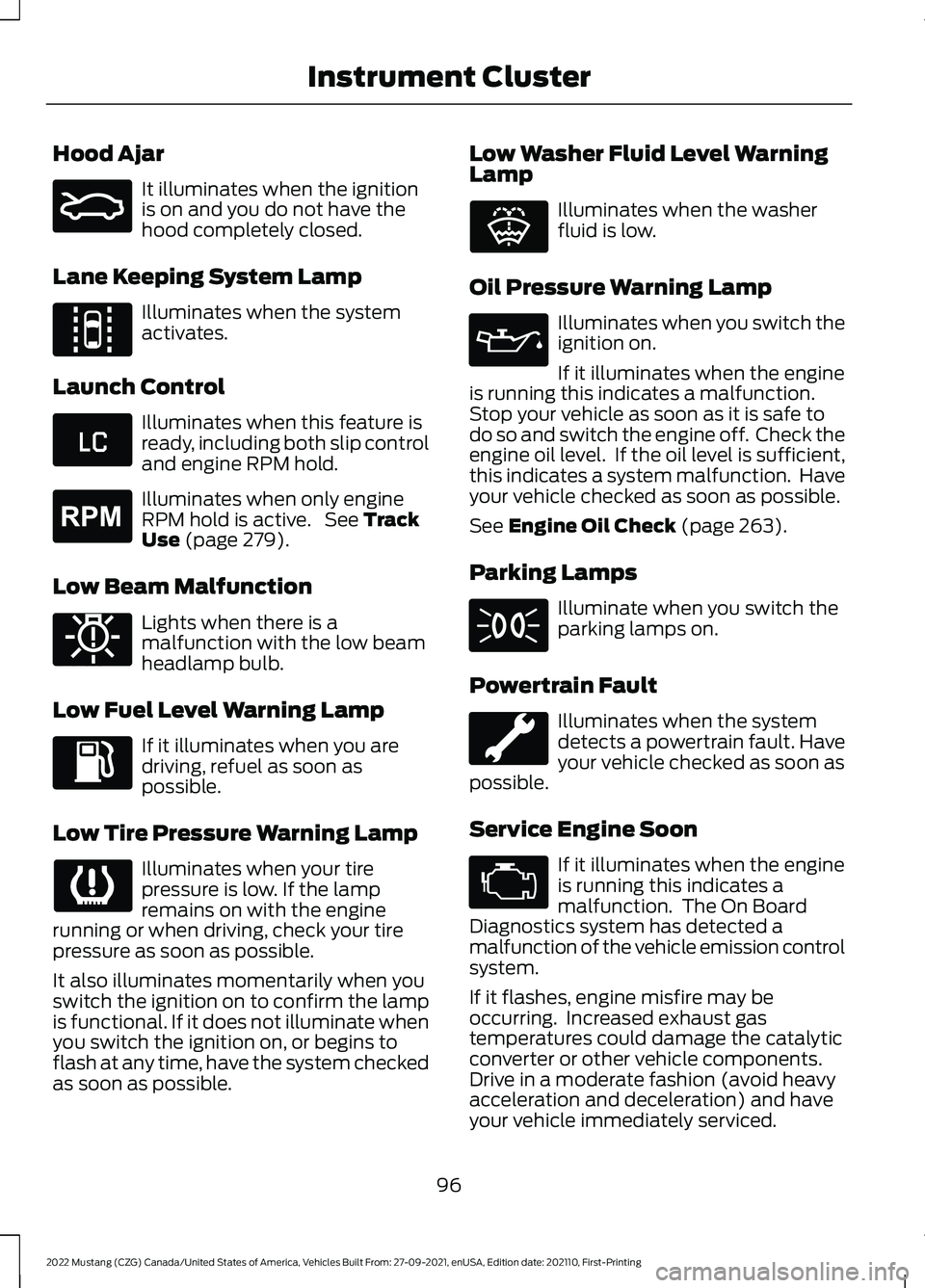
Hood Ajar
It illuminates when the ignition
is on and you do not have the
hood completely closed.
Lane Keeping System Lamp Illuminates when the system
activates.
Launch Control Illuminates when this feature is
ready, including both slip control
and engine RPM hold.
Illuminates when only engine
RPM hold is active. See Track
Use (page 279).
Low Beam Malfunction Lights when there is a
malfunction with the low beam
headlamp bulb.
Low Fuel Level Warning Lamp If it illuminates when you are
driving, refuel as soon as
possible.
Low Tire Pressure Warning Lamp Illuminates when your tire
pressure is low. If the lamp
remains on with the engine
running or when driving, check your tire
pressure as soon as possible.
It also illuminates momentarily when you
switch the ignition on to confirm the lamp
is functional. If it does not illuminate when
you switch the ignition on, or begins to
flash at any time, have the system checked
as soon as possible. Low Washer Fluid Level Warning
Lamp Illuminates when the washer
fluid is low.
Oil Pressure Warning Lamp Illuminates when you switch the
ignition on.
If it illuminates when the engine
is running this indicates a malfunction.
Stop your vehicle as soon as it is safe to
do so and switch the engine off. Check the
engine oil level. If the oil level is sufficient,
this indicates a system malfunction. Have
your vehicle checked as soon as possible.
See Engine Oil Check (page 263).
Parking Lamps Illuminate when you switch the
parking lamps on.
Powertrain Fault Illuminates when the system
detects a powertrain fault. Have
your vehicle checked as soon as
possible.
Service Engine Soon If it illuminates when the engine
is running this indicates a
malfunction. The On Board
Diagnostics system has detected a
malfunction of the vehicle emission control
system.
If it flashes, engine misfire may be
occurring. Increased exhaust gas
temperatures could damage the catalytic
converter or other vehicle components.
Drive in a moderate fashion (avoid heavy
acceleration and deceleration) and have
your vehicle immediately serviced.
96
2022 Mustang (CZG) Canada/United States of America, Vehicles Built From: 27-09-2021, enUSA, Edition date: 202110, First-Printing Instrument ClusterE159324 E144813 E234583 E255688 E181350 E132353
Page 121 of 528
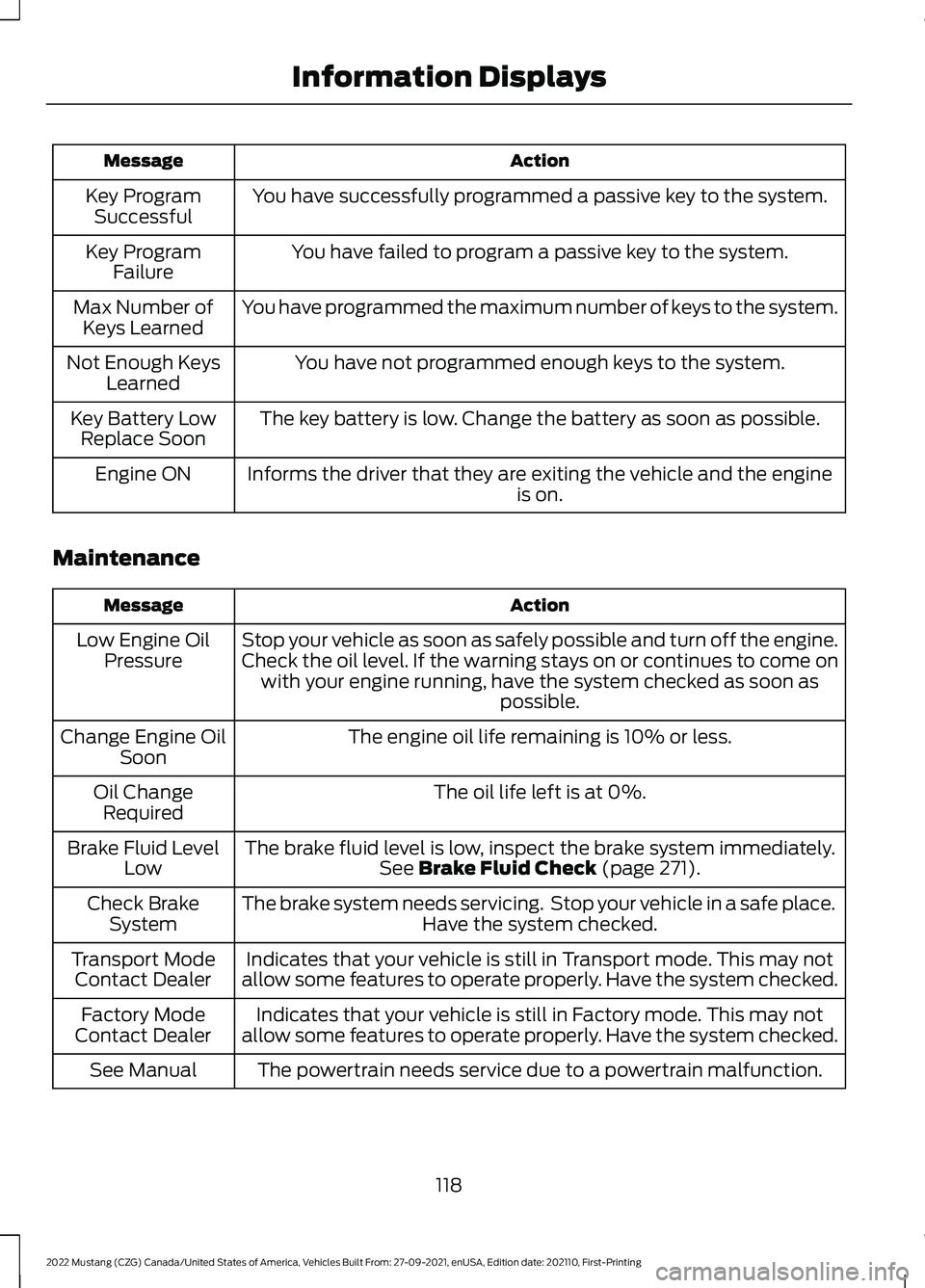
Action
Message
You have successfully programmed a passive key to the system.
Key Program
Successful
You have failed to program a passive key to the system.
Key Program
Failure
You have programmed the maximum number of keys to the system.
Max Number of
Keys Learned
You have not programmed enough keys to the system.
Not Enough Keys
Learned
The key battery is low. Change the battery as soon as possible.
Key Battery Low
Replace Soon
Informs the driver that they are exiting the vehicle and the engine is on.
Engine ON
Maintenance Action
Message
Stop your vehicle as soon as safely possible and turn off the engine.
Check the oil level. If the warning stays on or continues to come onwith your engine running, have the system checked as soon as possible.
Low Engine Oil
Pressure
The engine oil life remaining is 10% or less.
Change Engine Oil
Soon
The oil life left is at 0%.
Oil Change
Required
The brake fluid level is low, inspect the brake system immediately.See Brake Fluid Check (page 271).
Brake Fluid Level
Low
The brake system needs servicing. Stop your vehicle in a safe place. Have the system checked.
Check Brake
System
Indicates that your vehicle is still in Transport mode. This may not
allow some features to operate properly. Have the system checked.
Transport Mode
Contact Dealer
Indicates that your vehicle is still in Factory mode. This may not
allow some features to operate properly. Have the system checked.
Factory Mode
Contact Dealer
The powertrain needs service due to a powertrain malfunction.
See Manual
118
2022 Mustang (CZG) Canada/United States of America, Vehicles Built From: 27-09-2021, enUSA, Edition date: 202110, First-Printing Information Displays
Page 123 of 528

Park Brake
Action
Message
You have set the parking brake and you have driven the vehicle
more than 3 mph (5 km/h). If the warning stays on after you have
released the parking brake, have the system checked.
Park Brake
Engaged
Pre-Collision Assist Action
Message
You have a blocked sensor due to inclement weather, ice, mud or
water in front of the radar sensor. You can typically clean the sensor
to resolve.
Pre-Collision
Assist Not Avail- able SensorBlocked
A fault with the system has occurred. Have the system checked as
soon as possible.
Pre-Collision
Assist Not Avail- able
Rear Axle Action
Message
This message appears when the oil temperature in the rear differ-ential exceeds a safe limit. Reduce speed to allow the oil temper- ature to return to normal levels.
Axle Over Temper-
ature Reduce Speed
Remote Start Action
Message
A reminder to apply the brake and push the start button to driveyour vehicle after a remote start.
To Drive: Press
Brake and Start Button
A reminder to push the start button to drive your vehicle after a remote start.
To Drive: Press
Start Button
120
2022 Mustang (CZG) Canada/United States of America, Vehicles Built From: 27-09-2021, enUSA, Edition date: 202110, First-Printing Information Displays
Page 163 of 528
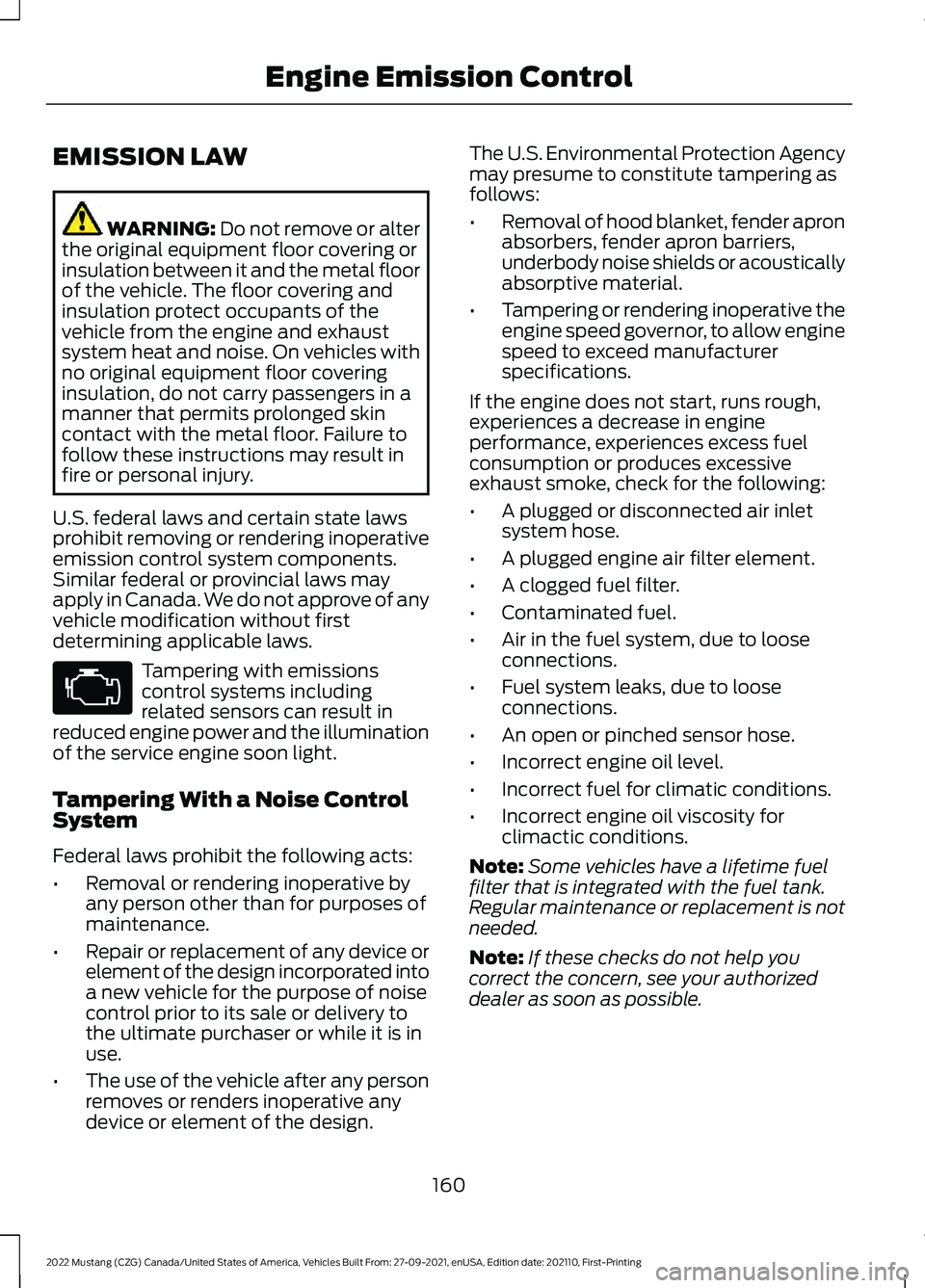
EMISSION LAW
WARNING: Do not remove or alter
the original equipment floor covering or
insulation between it and the metal floor
of the vehicle. The floor covering and
insulation protect occupants of the
vehicle from the engine and exhaust
system heat and noise. On vehicles with
no original equipment floor covering
insulation, do not carry passengers in a
manner that permits prolonged skin
contact with the metal floor. Failure to
follow these instructions may result in
fire or personal injury.
U.S. federal laws and certain state laws
prohibit removing or rendering inoperative
emission control system components.
Similar federal or provincial laws may
apply in Canada. We do not approve of any
vehicle modification without first
determining applicable laws. Tampering with emissions
control systems including
related sensors can result in
reduced engine power and the illumination
of the service engine soon light.
Tampering With a Noise Control
System
Federal laws prohibit the following acts:
• Removal or rendering inoperative by
any person other than for purposes of
maintenance.
• Repair or replacement of any device or
element of the design incorporated into
a new vehicle for the purpose of noise
control prior to its sale or delivery to
the ultimate purchaser or while it is in
use.
• The use of the vehicle after any person
removes or renders inoperative any
device or element of the design. The U.S. Environmental Protection Agency
may presume to constitute tampering as
follows:
•
Removal of hood blanket, fender apron
absorbers, fender apron barriers,
underbody noise shields or acoustically
absorptive material.
• Tampering or rendering inoperative the
engine speed governor, to allow engine
speed to exceed manufacturer
specifications.
If the engine does not start, runs rough,
experiences a decrease in engine
performance, experiences excess fuel
consumption or produces excessive
exhaust smoke, check for the following:
• A plugged or disconnected air inlet
system hose.
• A plugged engine air filter element.
• A clogged fuel filter.
• Contaminated fuel.
• Air in the fuel system, due to loose
connections.
• Fuel system leaks, due to loose
connections.
• An open or pinched sensor hose.
• Incorrect engine oil level.
• Incorrect fuel for climatic conditions.
• Incorrect engine oil viscosity for
climactic conditions.
Note: Some vehicles have a lifetime fuel
filter that is integrated with the fuel tank.
Regular maintenance or replacement is not
needed.
Note: If these checks do not help you
correct the concern, see your authorized
dealer as soon as possible.
160
2022 Mustang (CZG) Canada/United States of America, Vehicles Built From: 27-09-2021, enUSA, Edition date: 202110, First-Printing Engine Emission Control
Page 254 of 528

Protected Component
Fuse Rating
Fuse or Relay
Number
Auxiliary power point.
20A 2
54
Electronic fan 2 (base).
25A 2
55
Not used (GT500).
—
Not used.
—
56
Air conditioning clutch relay.
—
57
Not used.
—
58
Exhaust valves relay.
—
59
Powertrain control module.
5A 3
60
Not used.
—
61
Anti-lock brakes run/start switch.
5A 3
62
Not used.
—
63
Electronic power assist steering.
5A 3
64
Not used.
—
65
Blind spot information system.
5A 3
66 Rear view camera.
Rear window defroster relay coils.
Vehicle dynamics module.
Not used.
—
67
Headlamp leveling switch (base).
10A 3
68
Signature lighting (GT500).
10A 3
Cigar lighter relay.
—
69
Auxiliary power point relay.
Mass air flow sensor (base).
5A 3
74
Not used (GT500).
—
Rain sensor module (base).
5A 3
75
251
2022 Mustang (CZG) Canada/United States of America, Vehicles Built From: 27-09-2021, enUSA, Edition date: 202110, First-Printing Fuses
Page 266 of 528

ENGINE OIL DIPSTICK
Minimum.
A
Nominal.
B
Maximum.
C
ENGINE OIL CHECK
1. Make sure that your vehicle is on level ground.
2. Check the oil level before starting the engine, or switch the engine off after
warm up and wait 10 minutes for the
oil to drain into the oil pan.
3. Remove the dipstick and wipe it with a clean, lint-free cloth.
4. Reinstall the dipstick and make sure it is fully seated.
5. Remove the dipstick again to check the
oil level.
Note: If the oil level is between the
maximum and minimum marks, the oil level
is acceptable. Do not add oil.
6. If the oil level is at the minimum mark, immediately add oil.
7. Reinstall the dipstick. Make sure it is fully seated. Note:
The oil consumption of new engines
reaches its normal level after approximately
3,000 mi (5,000 km).
Adding Engine Oil WARNING:
Do not add engine oil
when the engine is hot. Failure to follow
this instruction could result in personal
injury. WARNING: Do not remove the filler
cap when the engine is running.
Do not use supplemental engine oil
additives because they are unnecessary
and could lead to engine damage that the
vehicle warranty may not cover.
1. Clean the area surrounding the engine oil filler cap before you remove it.
2. Remove the engine oil filler cap.
3. Add engine oil that meets our specifications. See
Capacities and
Specifications (page 338).
4. Reinstall the engine oil filler cap. Turn it clockwise until you feel a strong
resistance.
Note: Do not add oil further than the
maximum mark. Oil levels above the
maximum mark may cause engine damage.
Note: Immediately soak up any oil spillage
with an absorbent cloth.
Engine Oil Pressure Warning Lamp WARNING:
If it illuminates when
you are driving do not continue your
journey, even if the oil level is correct.
Have your vehicle checked. It illuminates when you switch
the ignition on.
263
2022 Mustang (CZG) Canada/United States of America, Vehicles Built From: 27-09-2021, enUSA, Edition date: 202110, First-Printing MaintenanceE270482
Page 267 of 528

If it illuminates when the engine is running
this indicates a malfunction. Stop your
vehicle as soon as it is safe to do so and
switch the engine off. Check the engine oil
level. If the oil level is sufficient, this
indicates a system malfunction. Have your
vehicle checked as soon as possible.
OIL CHANGE INDICATOR
RESET
Use the information display controls on
the steering wheel to reset the oil change
indicator.
From the main menu scroll to:
Action and description
Message
Press the right arrow button,
then from this menu scroll
to the following message.
Settings
Press OK
Advanced
Settings
Press the right arrow button,
then from this menu scroll
to the following message.
Vehicle
Press the right arrow button,
then from this menu scroll
to the following message.
Oil Life
Press and hold the OK
button until the instrument
cluster displays the
following message.
Hold OK to
Reset
Reset Successful
When the oil change indic-
ator resets the instrument
cluster displays 100%.
Remaining Life
{00}% Action and description
Message
If the instrument cluster
displays one of the following
messages, repeat the
process.
Not Reset
Reset Cancelled
CHANGING THE ENGINE AIR
FILTER - 5.0L, MACH 1 WARNING:
To reduce the risk of
vehicle damage and personal burn
injuries, do not start your engine with the
air cleaner removed and do not remove
it while the engine is running.
See the scheduled maintenance
information for the appropriate intervals
for changing the air filter element.
When changing the air filter element, use
only the Motorcraft™ air filter element
listed. See the Motorcraft part numbers in
the Capacities and Specifications chapter. 264
2022 Mustang (CZG) Canada/United States of America, Vehicles Built From: 27-09-2021, enUSA, Edition date: 202110, First-Printing MaintenanceE272660
Page 282 of 528

TRACK USE - MACH 1
Operating at High Speeds and
Track Days
Your vehicle is capable of sustained high
speeds and track day driving.
Before operating your vehicle at high
speeds:
•
Verify your tires have the correct
pressures.
• Inspect wheels and tires for wear and
damage. Replace any damaged wheels
and tires.
• Check and set lug nut torque. See
Technical Specifications (page 337).
• Verify fluid levels for oil, coolant, brake
and hydraulic fluid. See
Capacities
and Specifications (page 338).
• Change the engine oil and replace the
engine oil filter prior to use on the track.
Change the engine oil and filter again
after every four hours of track time.
Maintain the engine oil level at or near
the max mark on the engine oil dipstick.
See
Engine Oil Check (page 263).
• Replace the brake fluid with fresh
Motorcraft/Ford DOT 4 LV High
Performance Brake Fluid or other DOT
compliant fluid with a dry boiling point
greater than
500°F (260°C) from a
sealed container. Do not use silicone
or DOT 5 brake fluids. •
If you are operating your Mach 1 on a
drag strip, use drag strip selectable
drive mode in addition to using line lock
and launch control to provide a specific
set-up tuned for the quickest straight
line elapsed times.
• If you are operating your Mach 1 on a
road course, use sport or track
selectable drive modes to provide a
specific set-up tuned for optimal shift
and suspension set-up that is tuned
towards handling prowess on closed
course surfaces.
After operating your vehicle at high speeds
or track day driving, do the following:
• Set the tire pressure to the proper
specification.
• Check and set the lug nut torque. See
Technical Specifications (page
337).
• Check all fluid levels.
• Refer to the track maintenance interval
chart. See
Normal Scheduled
Maintenance (page 452).
• Check the front and rear wheel
bearings for abnormal wear.
• Inspect brake caliper dust boots for
abnormal wear.
Track Apps WARNING:
Track Apps™
is for
track use only. Remember that even
advanced technology cannot defy the
laws of physics. It is always possible to
lose control of a vehicle due to
inappropriate driver input for the
conditions. Aggressive driving on any
road condition can cause you to lose
control of your vehicle increasing the risk
of personal injury or property damage.
279
2022 Mustang (CZG) Canada/United States of America, Vehicles Built From: 27-09-2021, enUSA, Edition date: 202110, First-Printing Track Use
(If Equipped)